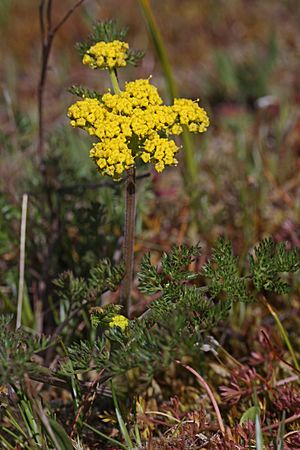Lomatium facts for kids
Quick facts for kids Lomatium |
|
|---|---|
 |
|
| Lomatium utriculatum | |
| Scientific classification | |
| Kingdom: | |
| (unranked): | |
| (unranked): | |
| (unranked): | |
| Order: | |
| Family: | |
| Tribe: |
Selineae
|
| Genus: |
Lomatium
|
| Species | |
|
See text |
|
Lomatium is a group of about 75 different plant types, also known as biscuitroot, Indian parsley, or desert parsley. These plants are perennial herbs, meaning they live for more than two years. They grow naturally in western North America.
Lomatium plants belong to the family Apiaceae. This family includes many plants we eat, like carrots and celery. Some types of Lomatium were very important to Native Americans in the inland Northwest. They used these plants as a main part of their diet.
Contents
What Lomatium Looks Like
The roots of Lomatium plants can be different. Some have tough, woody taproots, which are like a single main root. Others have thicker, fleshy roots that store food underground.
Most Lomatium species live in desert areas or on rocky cliffs. In these places, there isn't much water for most of the year. The plants grow best in spring when water is available. During this time, they are green and make their food using sunlight.
After spring, they produce seeds and the parts above ground dry out completely. This happens before the hottest part of the year. The plants store the energy they made in their deep roots. For most of the year, you can't see the plant above ground. The dry tops often blow away or get crushed. But the plant stays alive underground, waiting for the next spring.
Flowers and Fruits
The flowers of Lomatium grow in clusters called umbels. These are like tiny umbrellas, with many small flowers on stalks that spread out from one point. The flowers are usually white or yellow. Sometimes, they can be purple or maroon.
The fruit of Lomatium is special. It helps tell these plants apart from other similar-looking flowers. The fruits are flat and have wings. These wings can be thin like paper or thick like cork. They help the seeds fly further in the wind.
Leaves
The leaves of Lomatium plants mostly grow from the base of the plant. They are often deeply cut or divided into many small parts. Many of them look like ferns.
Where Lomatium Grows
Lomatium plants grow in many different places across western North America. You can find them on coastal cliffs or on piles of basalt rock.
Protecting Lomatium
Many Lomatium species are facing threats. Their homes are being damaged by animals grazing (eating plants), new buildings, and wildfires. There is also concern about some specific types, like Lomatium dissectum. This plant is often collected from the wild for use in herbal medicine.
It can be hard to tell different Lomatium species apart. But these plants have a lot of different genes, which means new species are still being discovered today. For example, Lomatium tarantuloides is a newly found species. Many Lomatium species only grow in a very small area and are rare.
How People Use Lomatium
Several types of Lomatium, such as L. cous, L. geyeri, and L. macrocarpum, are known as biscuit roots. This is because their roots are full of starch and can be eaten.
These plants were important traditional foods for Native Americans. They would cook the roots or dry them and grind them into flour. Some Native Americans would grind Lomatium into a soft paste. They would then shape this paste into cakes and store them to eat later. The taste of these roots has been compared to celery, parsnip, or even stale biscuits.
Selected Species
See also
 In Spanish: Lomatium para niños
In Spanish: Lomatium para niños

